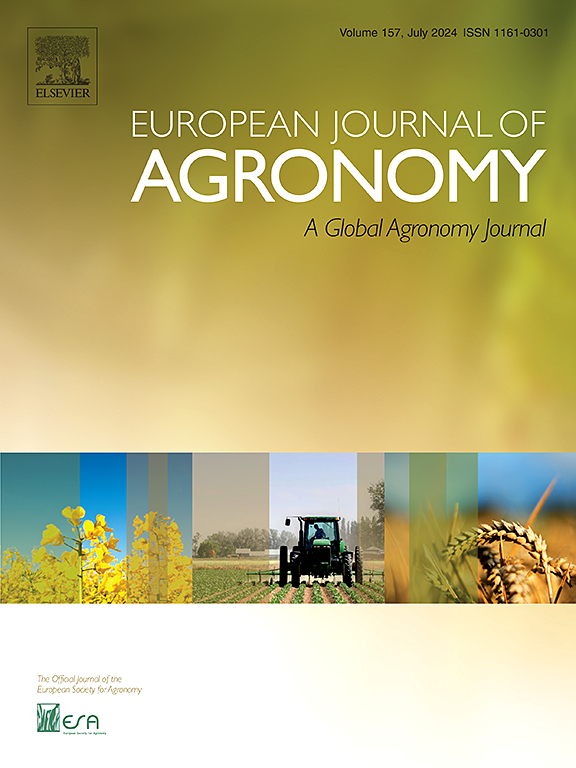Evaluating the AgMIP calibration protocol for crop models; case study and new diagnostic tests
IF 4.5
1区 农林科学
Q1 AGRONOMY
引用次数: 0
Abstract
Crop simulation models are important tools in agronomy. Typically, they need to be calibrated before being used for new environments or cultivars. However, there is a large variability in calibration approaches, which contributes to uncertainty in simulated values, so it is important to develop improved calibration procedures that are widely applicable. The AgMIP calibration group recently proposed a comprehensive, generic calibration protocol that is directly based on standard statistical parameter estimation in regression models. Weighted least squares (WLS) is used to handle multiple response variables and forward regression using the corrected Akaike Information Criterion (AICc) is used to select the parameters to be calibrated. The protocol includes two adaptations, which are specific to each model and data set. First, initial approximations to the WLS parameters are obtained by fitting variables one group at a time. Secondly, “major” parameters are identified that are intended to reduce bias, analogously to the constant in linear regression. In this study, new diagnostic tools to be included in the protocol are proposed and tested in a case study. The diagnostics test whether the protocol does indeed lead to good initial approximations to the WLS parameters, and whether the protocol does indeed substantially reduce bias. These diagnostics provide in-depth understanding of the calibration process, reveal problems and help suggest solutions. The diagnostics should increase confidence in the results of the protocol. Having a reliable, generic calibration approach, like the augmented AgMIP protocol, is essential to using crop models more effectively.
作物模型AgMIP校准方案的评估案例研究和新的诊断测试
作物模拟模型是农学研究的重要工具。通常,它们需要在用于新环境或新品种之前进行校准。然而,校准方法有很大的可变性,这导致了模拟值的不确定性,因此制定改进的校准程序是很重要的,它可以广泛适用。AgMIP校准小组最近提出了一种全面的通用校准方案,该方案直接基于回归模型中的标准统计参数估计。采用加权最小二乘(WLS)对多个响应变量进行处理,利用修正后的赤池信息准则(AICc)进行正回归选择待标定参数。该协议包括两种特定于每个模型和数据集的调整。首先,通过一次拟合一组变量来获得WLS参数的初始近似。其次,确定旨在减少偏差的“主要”参数,类似于线性回归中的常数。在这项研究中,提出了新的诊断工具,包括在协议和测试在一个案例研究。诊断测试方案是否确实导致了WLS参数的良好初始近似,以及方案是否确实大大减少了偏差。这些诊断提供了对校准过程的深入了解,揭示问题并帮助提出解决方案。诊断应增加对方案结果的信心。拥有一种可靠的通用校准方法,如增强的AgMIP协议,对于更有效地使用作物模型至关重要。
本文章由计算机程序翻译,如有差异,请以英文原文为准。
求助全文
约1分钟内获得全文
求助全文
来源期刊

European Journal of Agronomy
农林科学-农艺学
CiteScore
8.30
自引率
7.70%
发文量
187
审稿时长
4.5 months
期刊介绍:
The European Journal of Agronomy, the official journal of the European Society for Agronomy, publishes original research papers reporting experimental and theoretical contributions to field-based agronomy and crop science. The journal will consider research at the field level for agricultural, horticultural and tree crops, that uses comprehensive and explanatory approaches. The EJA covers the following topics:
crop physiology
crop production and management including irrigation, fertilization and soil management
agroclimatology and modelling
plant-soil relationships
crop quality and post-harvest physiology
farming and cropping systems
agroecosystems and the environment
crop-weed interactions and management
organic farming
horticultural crops
papers from the European Society for Agronomy bi-annual meetings
In determining the suitability of submitted articles for publication, particular scrutiny is placed on the degree of novelty and significance of the research and the extent to which it adds to existing knowledge in agronomy.
 求助内容:
求助内容: 应助结果提醒方式:
应助结果提醒方式:


